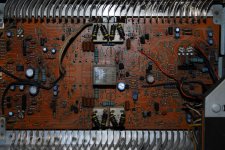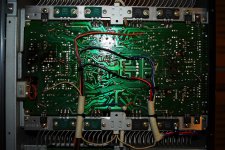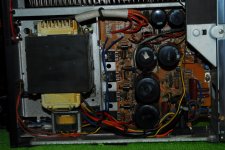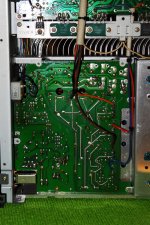I'm looking for a tech in Toronto willing to help me repair and troubleshoot an old friend. This amp worked flawlessly up until a few days ago when it started blowing fuses. I only had a 4 pack of the MDX7 style fuses as replacements so after the second one blew I removed the amp for inspection.
Inspection revealed nothing, no real burnt spots, and no evidence of real damage.
There are apparently mods available for this amp to improve performance and would be a plus to add these features also while repairing.
Any young tech willing to give it a once over or willing to give me a list of what needs to be repaired I'd be grateful. Hell there may even be a few beers in it for you 😉 . PM me or leave a reply here and we can go from there.
I really don't want to scrap this amp, but am not willing to pay tech prices when I can repair the issue once the issue is found.
Thanks for any help in advance.
Inspection revealed nothing, no real burnt spots, and no evidence of real damage.
There are apparently mods available for this amp to improve performance and would be a plus to add these features also while repairing.
Any young tech willing to give it a once over or willing to give me a list of what needs to be repaired I'd be grateful. Hell there may even be a few beers in it for you 😉 . PM me or leave a reply here and we can go from there.
I really don't want to scrap this amp, but am not willing to pay tech prices when I can repair the issue once the issue is found.
Thanks for any help in advance.
If these are glass fuses, are they blackened or did the fuse element just melt?
Blackened = dead short
Melted = overloaded but not shorted
The first places to look in an amp for shorts are the rectifiers (easy to check, usually blacken the fuse when the short), the large filter caps and of course, the output transistors.
Blackened = dead short
Melted = overloaded but not shorted
The first places to look in an amp for shorts are the rectifiers (easy to check, usually blacken the fuse when the short), the large filter caps and of course, the output transistors.
Yup big crackly spark ending in a blackened fuse. Something tells me it's the supply caps because when I opened the amp up, and re-installed a fuse to see if I could see/hear anything the power supply transformer hummed and then a spark from the fuse.... I'll try and do some measurements and post them here, although I'm no tech I do have a DMM and screwdrivers LOL. I'll check the caps, rectifiers and the output transistors and get back to you people on any readings.
Thanks again.
Thanks again.
It could be anything with a direct connection to the main voltage rails. Got pics of the insides?
The transformer humming is due to overload as well.
The transformer humming is due to overload as well.
I really don't want to scrap this amp, but am not willing to pay tech prices when I can repair the issue once the issue is found.
A company has a large expensive press that keeps cracking in the same location after running a few days. After several attempts to weld the crack they finally call in a consulting engineer. He studies the machine and the nature of the failure, then draws a sketch calling for them to weld in two small gussetts on either side of the area that's cracking and that should fix the problem. Sure enough they follow his instructions and the machine runs reliably for weeks. Then a bill arrives from the engineer as follows:
-Evaluate press for cracking and recommend solution $50,000
The company president calls the engineer and questions how such a simple fix could possibly be worth that much. He then insists the engineer submit an itemized bill for the work. Several days later they received the revised invoice:
-Travel by car to your plant and back $ 75
-Inspect machine to determine cause of failure $ 500
-Draft and provide sketch defining repair procedure $ 250
-Knowing why gussets were needed and where to put them $ 49,175
-Total amount due $50,000
The bill was promptly paid in full.😉
Fortunately you have a poor engineering student here that feels your pain and is willing to help. 😀
Yup, getting paid for what you know is what we all live to do correct? But this is DIY audio, not a referral service to a technician style board. I understand that sometimes you get what you pay for, but in this circumstance I feel it necessary to remind you that I am not willing to pay a tech if the repair can be done by myself DIY style. If in the end I feel the repair needs to be done by a pro, I have a board here available that can provide me with some pretty capable hands. But until I deem this impossible I'd rather try and rectify this myself, and if help is provided then I greatly appreciate the help.... And I did mention beer and I'll even provide tunes LOL so it's not so much a free ride.
Hey, thanks for the comment it helped out a great deal 😛 .
Hey, thanks for the comment it helped out a great deal 😛 .
A company has a large expensive press that keeps cracking in the same location after running a few days. After several attempts to weld the crack they finally call in a consulting engineer. He studies the machine and the nature of the failure, then draws a sketch calling for them to weld in two small gussetts on either side of the area that's cracking and that should fix the problem. Sure enough they follow his instructions and the machine runs reliably for weeks. Then a bill arrives from the engineer as follows:
-Evaluate press for cracking and recommend solution $50,000
The company president calls the engineer and questions how such a simple fix could possibly be worth that much. He then insists the engineer submit an itemized bill for the work. Several days later they received the revised invoice:
-Travel by car to your plant and back $ 75
-Inspect machine to determine cause of failure $ 500
-Draft and provide sketch defining repair procedure $ 250
-Knowing why gussets were needed and where to put them $ 49,175
-Total amount due $50,000
The bill was promptly paid in full.😉
Do some searches on this forum. I recall several posts saying that the Carvers were a 'different type of beast.' The average serviceman may have troubles with them and they are not too DIY-friendly. Look up posts by Anatech, a tech with a good deal of experience with Carvers and is fairly local to you (Georgetown). I'm not sure how is health is these days as I haven't seen him post in some time. From my reading on this forum you are likely looking at a problem that requires someone quite a bit of experience (ie, not a DIY-er).
Steve.
Steve.
Hi,
The fuse that is blowing it is the main fuse. If it is then you possible have a bad rectifiers in the power supply. If it blowing the main fuses.
Regards,
tauro0221
The fuse that is blowing it is the main fuse. If it is then you possible have a bad rectifiers in the power supply. If it blowing the main fuses.
Regards,
tauro0221
Aww man...a quick Google search for some pics of the insides reveals a rather complex power supply of unknown type. It doesn't appear to be an SMPS, the transformer is too large.
My bet is that this thing has the Carver "Tracking Downconverter" or perhaps an earlier but similar system. I believe it is simply Class H on steroids where instead of an upper and lower voltage rail that is switched based on demand, the supply linearly ramps up the supply rails with demand for higher efficiency. I'd need a larger pic to really see the whole picture.
In any case, the PSU is complex and a divide and conquer strategy is definitely required. We need to isolate the PSU from the amp electrically to determine if it's a shorted amp or something in the PSU.
So post up some pics so we can see if you have the same circuit (BIG pics!) and find where the amp power wires are and disconnect them.
If the fuse pops with the PSU disconnected from the amp, the fault is almost certainly in the PSU (unless the PSU gets cranky without its amp but this isn't likely...and would definitely be a poor design, something I wouldn't expect from Carver.)
My bet is that this thing has the Carver "Tracking Downconverter" or perhaps an earlier but similar system. I believe it is simply Class H on steroids where instead of an upper and lower voltage rail that is switched based on demand, the supply linearly ramps up the supply rails with demand for higher efficiency. I'd need a larger pic to really see the whole picture.
In any case, the PSU is complex and a divide and conquer strategy is definitely required. We need to isolate the PSU from the amp electrically to determine if it's a shorted amp or something in the PSU.
So post up some pics so we can see if you have the same circuit (BIG pics!) and find where the amp power wires are and disconnect them.
If the fuse pops with the PSU disconnected from the amp, the fault is almost certainly in the PSU (unless the PSU gets cranky without its amp but this isn't likely...and would definitely be a poor design, something I wouldn't expect from Carver.)
Last edited:
You may want to take a look over at CARVER site there are several members with deep expertise and one who does upgrades on the 500T.
The power supply works light a light dimmer. there is a triac that "fires" and triggers a mag coil which is not the same thing as a transformer. a mag coil works more like the ignition coil in a car. you apply power for a short duration and when you shut the power off, the magnetic field collapses and a large amount of energy is produced.
IF the triac has shorted. it will blow fuses as you describe. Do you have a variac?
IF the triac has shorted. it will blow fuses as you describe. Do you have a variac?
Hi .. I have some 30 carver amps.....
So there is something wrong in primary regulation.....triac or steering electronic. Second possibility is there is something wrong at secondary....some diode rectifier bridge or some filter cap....transformer itself is probably ok.....but if you are not confident to repair it yourself send it to someone who know how to....this amp is a little more complicated than common simple psu amps.
Best regards, Taj
So there is something wrong in primary regulation.....triac or steering electronic. Second possibility is there is something wrong at secondary....some diode rectifier bridge or some filter cap....transformer itself is probably ok.....but if you are not confident to repair it yourself send it to someone who know how to....this amp is a little more complicated than common simple psu amps.
Best regards, Taj
Wow...seems like an old fashioned way to make an SMPS.
Anyway, that TRIAC needs to be checked. If the way I understand this is correct, if the TRIAC shorts, that mag coil will saturate and draw a LOT of current.
Also, the big transistors and rectifiers need to be tested. The transistors will probably need to be desoldered for a check. The diodes are probably in circuit testable with the diode check function on your DMM.
Some of those caps look bulged....they are suspect.
Anyway, that TRIAC needs to be checked. If the way I understand this is correct, if the TRIAC shorts, that mag coil will saturate and draw a LOT of current.
Also, the big transistors and rectifiers need to be tested. The transistors will probably need to be desoldered for a check. The diodes are probably in circuit testable with the diode check function on your DMM.
Some of those caps look bulged....they are suspect.
yup it is a pretty crude way to do it. and yes if that triac is bad, it will draw lots of current. if you have a variac you can power it up slowly and watch for high current draw. if you can get to half line voltage without problems, then the triac is bad. Do not go past half line voltage. if it draws current below 1/4 line voltage, you have other problems!
Try to fix the PSU, but if that effort falls flat on it's face, I wonder if it's possible to get a toroidal transformer of suitable output for this unit?
EDIT...or perhaps one of those Chinese SMPS units? (I know, sacrilege!)
EDIT...or perhaps one of those Chinese SMPS units? (I know, sacrilege!)
Last edited:
The Carver mag field power supply is not an SMPS.
The coil itself, and the triac, are very stout and almost never fail.
If you feel comfortable working on electronics, I have a troubleshooting guide at: http://www.thecarversite.com/yetanotherforum/default.aspx?g=posts&m=18961#post18961
The coil itself, and the triac, are very stout and almost never fail.
If you feel comfortable working on electronics, I have a troubleshooting guide at: http://www.thecarversite.com/yetanotherforum/default.aspx?g=posts&m=18961#post18961
- Status
- Not open for further replies.
- Home
- Amplifiers
- Solid State
- Carver M-500t repair help.



